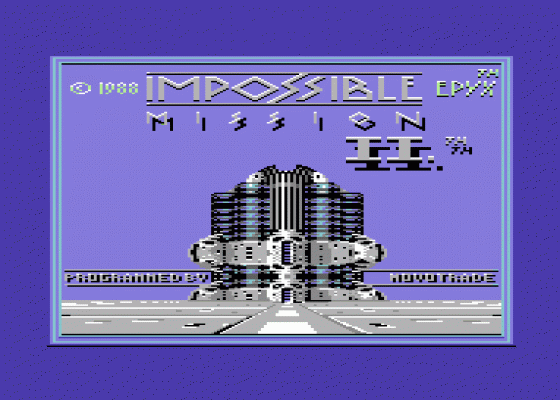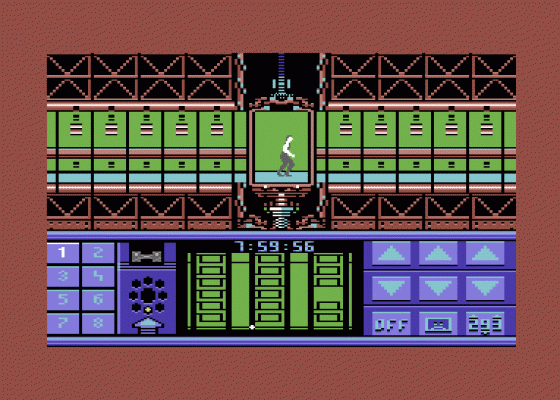Impossible Mission II
It's been two years since Special Agent 4125's last tough job. They called the Elvin Atombender affair an Impossible Mission, but 4125 proved otherwise, and since then he's been able to laze around on foreign beaches, his long-term assignment - to infiltrate a gang of Mediterranean Time-Share salesmen. He often likes to reminisce about the heady days of robot confrontations, of leaping sparks and leaping gaps... Such wistul memories are one day interrupted by the IMA Special Terrorist Unit informing him of the return of Atombender, this time with a missile with which he intends to destroy the world. Headquarters know there's only one man capable of defeating the mad genius again, so 4125 is immediately despatched to Atombender's eight-tower complex in the country, on Impossible Mission II.
Play begins eight hours from the launch, with 4125 in a lift shaft in a randomly-selected tower, only a swift jog away from one of the complex's many rooms. Each room is a clutter of platforms and lifts, patrolled by robot guards which the player negotiates by running, crouching and somersaulting. On the platforms are objects pertinent to the function of the particular tower, from cars in the garage tower to exercise bikes in the gymnasium.
The intrepid agent's overall objective is to find musical sequences which, when played together, open the express elevator door to take him to Atombender's missile control room. His more immediate task, however, is to search each object in each tower until he finds the component parts of numeric codes which open the security doors accessing neighbouring towers. Standing in front of the object and pushing up on the joystick produces a box containing a diminishing bar which represents how much of the object remains to be examined. Should a hazardous situation arise, 4125 can break off his search and return later to continue where he left off.

If an examination doesn't produce part of the security code it can prove fruitless, but more frequently turns up items to aid the player in his quest. These are security terminal commands which allow the player to change some of a room's features by accessing an on-screen computer. The screen then changes to show icons representing time bombs, mines, temporary robot deactivation, platform movement and room illumination. A count of each type of command collected is also displayed, as using one depletes 4125's supply.
Six types of robot patrol the catwalks, each having its own malevolent methods of agent elimination. The basic Sentrybot is armed with a gun which delivers a plasma challenge, fatal to any human within its six-feet range. Minebots crawl about the platforms laying mines while the outwardly similar Pestbots do nothing but ride the moving platforms, taking pleasure in moving one just as 4125 is about to land on it. Squatbots remain in one place, constantly extending and retracting like small lifts. If he's careful, these can give 4125 an extra jumping boost, but can just as easily crush him against the ceiling. The very common Bashbot is fitted with a mechanical grabber which takes hold of anyone it detects and pushes them off its platform, usually into empty space! The less common Suicidebot lives up to its name by grasping the nearest agent and leaping off the platform with him, thus dragging him to his doom.
Apart rom contact with a robot, death frequently occurs by mistiming a jump and falling through the floor. The player is quickly reincarnated at the entrance to the room but six minutes are deducted from his time limit.

Time remaining is checked on the pocket computer which fills the lower part of the screen when 4127 is in a corridor. This also displays a schematic of the tower and its two neighbours, with the ability to call up similar plans of all eight towers. The two main functions of the computer are the assembly of the three-digit numeric codes and the musical sequence.
As numbers are collected, they're logged into the computer, and the player uses it to alter their order until the correct combination is found. Musical sequences found in blown safes are recorded onto the computer's miniature cassette deck which has standard motor controls to allow the sequences to be edited together as they are found.
After duplicate sequences have been eliminated and the tune is complete, 4125 enters the express elevator, and then the control room. Apart from the swarm of robots, this room is occupied by three terminals, but only one halts the countdown - the other two impart instant death on the unfortunate agent.

Should time eventually run out, the game and the world both come to an end. The player's score is then calculated, based on numbers, objects and music found, towers completed and time remaining.
JR
Following up one of the greatest ever computer games is a very difficult thing, but Epyx have managed to produce a worthy sequel. The gameplay is fundamentally the same as the original, with Agent 4125 negotiating a platform environment, but there are many new twists.
Elvin's lair is split into eight towers of increasing difficulty, with some very tricky screens to explore. There are new robot guards, including kamikazes and lift movers, as well as some of the old favourites. There are also plenty of new hazards to avoid. Many screens have been extremely well designed to catch out even the most wary of Agents, and plenty of lateral thinking is required to reach the more inaccessible pieces of furniture.

Just for good measure, there are also plenty of objects to collect and time bombs and land mines are available for the destruction of floors and robots - and pieces of furniture if you're not careful!
I love the way the game is structured, with the Agent having to find both the codes to enable him to move from tower to tower and the tune for the express elevator to Elvin's lab.
The best thing of all is the new Pocket Computer, which allows you to splice and re-record the tune so that it activates the Express Lift. It's a brilliant idea, and drags you right into the action.
All this is played against the clock, with six minutes being knocked off the time limit every time the Agent becomes unstuck. This doesn't sound too bad at first, but start making mistakes and that time limit starts diminishing very rapidly indeed!
The game is excellently presented and has a series of superb backdrops, drawn with amazing attention to detail. Some of the robot sprites are a little indistinct, but overall the graphics generate just the right ambience.
One disappointing aspect is the sound - it's almost exactly the same as the original. The effects do generate a superb atmosphere, but it's a shame they couldn't have been improved even more. Impossible Mission II is an incredibly challenging, compelling and addictive game, and I've played it more than I've played anything in years.
GH
Even though Impossible Mission II lacks the appealing originality of its predecessor, the graphical improvement and increased depth in gameplay make it brilliantly compelling.
The presentation is generally good: apart from the unobtrusive disk access, everything is polished, from the gorgeous title screen to the high-score table (saved to disk). The basic features are the same - the speech, a combination of intelligent and dumb robots and super smooth animation throughout - but the overall gameplay has been enhanced: the sound seems crisper, time bombs and light switches have been included, new robots have been added.
These elements merge to create the same superb combination of addictive platform action (the individual rooms are deviously designed) and horrible puzzles. It's a great sequel to a brilliant game, and fully deserves a place in any self-respecting games player's collection.
PG
A follow-up to such a classic as Impossible Mission has quite a job on its hands if it's to avoid being a total disappointment. Any such fears are quickly proved groundless by a few games of Impossible Mission II, which, if anything, improves on the timeless classic with superior graphics, more variety in backdrops, and even more devilish obstacles.
The only very slight disappointment is that some new snatches of that superb digitised speech weren't added to give players of the original something a little extra. The new robots are an inspired addition, and prove even more wicked than their older counterparts, particularly the beguilingly innocuous Pestbot, which whips platforms out from under the player without a moment's notice.
The robots' cunning is only matched by the design of some of the rooms, which are at first glance impossible and only prove otherwise after much loss of liffe, necessitating long hours spent testing strategies. If you want more of a challenge than a platform game has ever given you before, try Impossible Mission II for size.
Verdict
Presentation 90%
Comprehensive instructions and excellent on-screen display. The disk version has a very useful Save Game facility.
Graphics 92%
Great sprite animation and tremendous attention to detail on backdrops.
Sound 83%
The same marvellous speech effects as Impossible Mission with a pleasant title tune.
Hookability 93%
Fiendish platform-puzzles prove horribly addictive.
Lastability 94%
It's supposed to be impossible, and it'll take much playing to prove otherwise.
Overall 96%
More superb a sequel than anyone could have hoped for.
Other Reviews Of Impossible Mission II For The Commodore 64/128
Impossible Mission 2 (Epyx)
A review by Gary Penn (Commodore User)
Zzapback 21-39
A review by Julian Rignall (Fusion Retro Books)


 1st June 1988
1st June 1988

